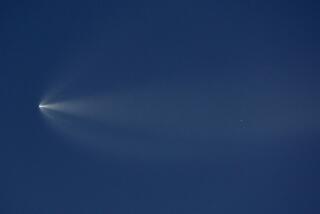SpaceX is launching rockets made with parts produced by a 3-D printer
SpaceX is printing rocket parts, including the thrust chamber on the engines for its Dragon V2 spacecraft, which it hopes will one day deliver NASA astronauts to the International Space Station.
The Hawthorne rocket maker announced Thursday that a Falcon 9 launch in January marked the first time it flew a part into space that was created using an additive manufacturing technique, popularly known as 3-D printing.
One of nine Merlin engines on the Falcon 9 included a printed part, known as a main oxidizer valve body, that houses the valve controlling the flow of liquid oxygen into the engine’s combustion chamber. It operated successfully under super-cold temperatures and high vibration, the company said.
Over the last several years, SpaceX has been evaluating and perfecting the fabrication technique it said. The process “prints” parts layer by layer, and promises advantages over traditional manufacturing methods.
The valve housing was printed in two days compared to months needed for traditional casting, but has superior strength and is less brittle. It has since qualified to be used interchangeably with cast parts, SpaceX said.
The company also printed an engine chamber for its SuperDraco engine, which it test fired at full thrust in late 2013. SpaceX plans to be the first to use a printed thrust chamber in a crewed space program later this year when it flies a demonstration of the Dragon’s launch escape system.
Eight SuperDraco engines provide 120,000 pounds of thrust to power the system, which is designed to carry astronauts to safety in case of a launch emergency. The engines also enable the spacecraft to land with the accuracy of a helicopter when it returns to Earth so it can be rapidly reused -- refueled and reflown -- which the company says would cut the cost of spaceflight significantly.
The additive manufacturing process has been used for years as a way to rapidly turn engineering designs into prototypes, but it has gained popularity among consumers recently because of the availability of desktop 3-D printers. Some industrial versions are more complex, and experts say the technology holds promise for aerospace manufacturing because it’s faster and cheaper, extremely accurate and capable of fabricating designs that are hard to make in traditional ways.
The 3-D printing process uses a laser to heat a layer of fine metal powder, fusing the powder in the shape of a super thin sliver of the part. Then another layer of powder is spread over the first and the process repeats for hundreds or thousands of layers until the part is complete.
The engine chamber was printed using Inconel, a super alloy, which dramatically shortened the timeline for producing the part compared to traditional methods, the company said. It has been fired more than 80 times and has clocked more than 300 seconds of hot fire.
Lawrence Livermore National Laboratory is also developing 3-D-printed rocket engines for low-cost launch vehicles for carrying small satellites into space. It printed a working prototype engine for a proposed launch vehicle in eight days at a cost of $10,000, according to its website.
SpaceX, short for Space Exploration Technologies Corp., builds its Dragon capsules and Falcon 9 rockets in a vast complex in Hawthorne. It is developing its hardware for manned spaceflight under NASA contracts worth more than $500 million.
Twitter: @chadgarland






